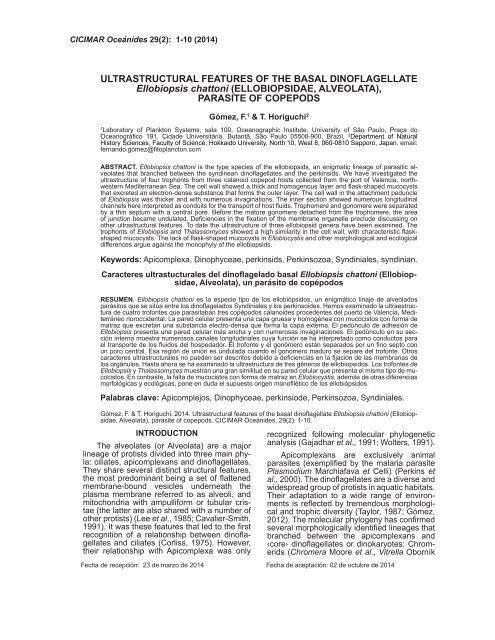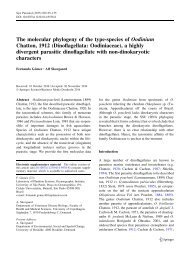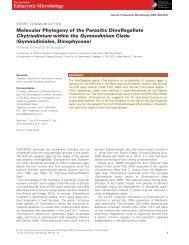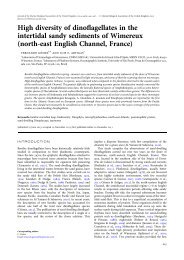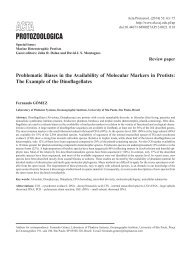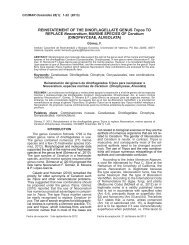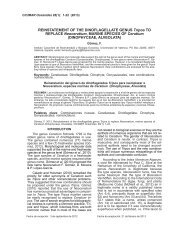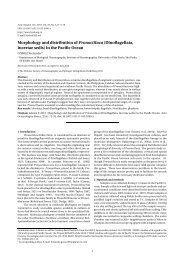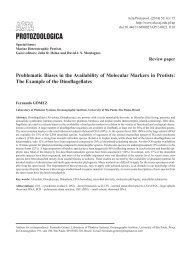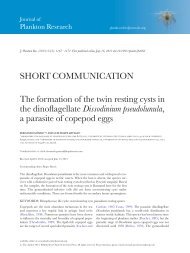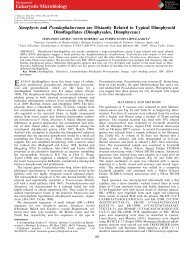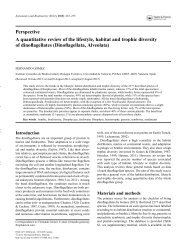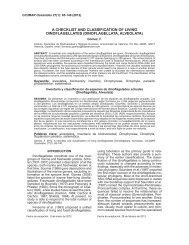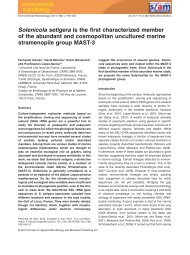ULTRASTRUCTURAL FEATURES OF THE BASAL DINOFLAGELLATE Ellobiopsis chattoni (ELLOBIOPSIDAE, ALVEOLATA), PARASITE OF COPEPODS
Ellobiopsis chattoni is the type species of the ellobiopsids, an enigmatic lineage of parasitic alveolates that branched between the syndinean dinoflagellates and the perkinsids. We have investigated the ultrastructure of four trophonts from three calanoid copepod hosts collected from the port of Valencia, northwestern Mediterranean Sea. The cell wall showed a thick and homogenous layer and flask-shaped mucocysts that excreted an electron-dense substance that forms the outer layer. The cell wall in the attachment peduncle of Ellobiopsis was thicker and with numerous invaginations. The inner section showed numerous longitudinal channels here interpreted as conduits for the transport of host fluids. Trophomere and gonomere were separated by a thin septum with a central pore. Before the mature gonomere detached from the trophomere, the area of junction became undulated. Deficiencies in the fixation of the membrane organelle preclude discussing on other ultrastructural features. To date the ultrastructure of three ellobiopsid genera have been examined. The trophonts of Ellobiopsis and Thalassomyces showed a high similarity in the cell wall, with characteristic flaskshaped mucocysts. The lack of flask-shaped mucocysts in Ellobiocystis and other morphological and ecological differences argue against the monophyly of the ellobiopsids.
Ellobiopsis chattoni is the type species of the ellobiopsids, an enigmatic lineage of parasitic alveolates
that branched between the syndinean dinoflagellates and the perkinsids. We have investigated the
ultrastructure of four trophonts from three calanoid copepod hosts collected from the port of Valencia, northwestern
Mediterranean Sea. The cell wall showed a thick and homogenous layer and flask-shaped mucocysts
that excreted an electron-dense substance that forms the outer layer. The cell wall in the attachment peduncle
of Ellobiopsis was thicker and with numerous invaginations. The inner section showed numerous longitudinal
channels here interpreted as conduits for the transport of host fluids. Trophomere and gonomere were separated
by a thin septum with a central pore. Before the mature gonomere detached from the trophomere, the area
of junction became undulated. Deficiencies in the fixation of the membrane organelle preclude discussing on
other ultrastructural features. To date the ultrastructure of three ellobiopsid genera have been examined. The
trophonts of Ellobiopsis and Thalassomyces showed a high similarity in the cell wall, with characteristic flaskshaped
mucocysts. The lack of flask-shaped mucocysts in Ellobiocystis and other morphological and ecological
differences argue against the monophyly of the ellobiopsids.
You also want an ePaper? Increase the reach of your titles
YUMPU automatically turns print PDFs into web optimized ePapers that Google loves.
CICIMAR Oceánides 29(2): 1-10 (2014)<br />
<strong>ULTRASTRUCTURAL</strong> <strong>FEATURES</strong> <strong>OF</strong> <strong>THE</strong> <strong>BASAL</strong> DIN<strong>OF</strong>LAGELLATE<br />
<strong>Ellobiopsis</strong> <strong>chattoni</strong> (<strong>ELLOBIOPSIDAE</strong>, <strong>ALVEOLATA</strong>),<br />
<strong>PARASITE</strong> <strong>OF</strong> <strong>COPEPODS</strong><br />
Gómez, F. 1 & T. Horiguchi 2<br />
1<br />
Laboratory of Plankton Systems, sala 100, Oceanographic Institute, University of São Paulo, Praça do<br />
Oceanográfico 191, Cidade Universitária, Butantã, São Paulo 05508-900, Brazil, 2 Department of Natural<br />
History Sciences, Faculty of Science, Hokkaido University, North 10, West 8, 060-0810 Sapporo, Japan. email:<br />
fernando.gomez@fitoplancton.com<br />
ABSTRACT. <strong>Ellobiopsis</strong> <strong>chattoni</strong> is the type species of the ellobiopsids, an enigmatic lineage of parasitic alveolates<br />
that branched between the syndinean dinoflagellates and the perkinsids. We have investigated the<br />
ultrastructure of four trophonts from three calanoid copepod hosts collected from the port of Valencia, northwestern<br />
Mediterranean Sea. The cell wall showed a thick and homogenous layer and flask-shaped mucocysts<br />
that excreted an electron-dense substance that forms the outer layer. The cell wall in the attachment peduncle<br />
of <strong>Ellobiopsis</strong> was thicker and with numerous invaginations. The inner section showed numerous longitudinal<br />
channels here interpreted as conduits for the transport of host fluids. Trophomere and gonomere were separated<br />
by a thin septum with a central pore. Before the mature gonomere detached from the trophomere, the area<br />
of junction became undulated. Deficiencies in the fixation of the membrane organelle preclude discussing on<br />
other ultrastructural features. To date the ultrastructure of three ellobiopsid genera have been examined. The<br />
trophonts of <strong>Ellobiopsis</strong> and Thalassomyces showed a high similarity in the cell wall, with characteristic flaskshaped<br />
mucocysts. The lack of flask-shaped mucocysts in Ellobiocystis and other morphological and ecological<br />
differences argue against the monophyly of the ellobiopsids.<br />
Keywords: Apicomplexa, Dinophyceae, perkinsids, Perkinsozoa, Syndiniales, syndinian.<br />
Caracteres ultrastucturales del dinoflagelado basal <strong>Ellobiopsis</strong> <strong>chattoni</strong> (Ellobiopsidae,<br />
Alveolata), un parásito de copépodos<br />
RESUMEN. <strong>Ellobiopsis</strong> <strong>chattoni</strong> es la especie tipo de los ellobiópsidos, un enigmático linaje de alveolados<br />
parásitos que se sitúa entre los dinoflagelados Syndiniales y los perkinsoides. Hemos examinado la ultraestructura<br />
de cuatro trofontes que parasitaban tres copépodos calanoides procedentes del puerto de Valencia, Mediterráneo<br />
noroccidental. La pared celular presenta una capa gruesa y homogénea con mucocistos con forma de<br />
matraz que excretan una substancia electro-densa que forma la capa externa. El pedúnculo de adhesión de<br />
<strong>Ellobiopsis</strong> presenta una pared celular más ancha y con numerosas invaginaciones. El pedúnculo en su sección<br />
interna muestra numerosos canales longitudinales cuya función se ha interpretado como conductos para<br />
el transporte de los fluidos del hospedador. El trofonte y el gonómero están separados por un fino septo con<br />
un poro central. Esa región de unión es undulada cuando el gonomero maduro se separe del trofonte. Otros<br />
caracteres ultrastructurales no pueden ser descritos debido a deficiencias en la fijación de las membranas de<br />
los orgánulos. Hasta ahora se ha examinado la ultrastructura de tres géneros de ellobiopsidos. Los trofontes de<br />
<strong>Ellobiopsis</strong> y Thalassomyces muestran una gran similitud en su pared celular que presenta el mismo tipo de mucocistos.<br />
En contraste, la falta de mucocistos con forma de matraz en Ellobiocystis, además de otras diferencias<br />
morfológicas y ecológicas, pone en duda el supuesto origen monofilético de los ellobiópsidos.<br />
Palabras clave: Apicomplejos, Dinophyceae, perkinsiode, Perkinsozoa, Syndiniales.<br />
Gómez, F. & T. Horiguchi. 2014. Ultrastructural features of the basal dinoflagellate <strong>Ellobiopsis</strong> <strong>chattoni</strong> (Ellobiopsidae,<br />
Alveolata), parasite of copepods. CICIMAR Oceánides, 29(2): 1-10.<br />
INTRODUCTION<br />
The alveolates (or Alveolata) are a major<br />
lineage of protists divided into three main phyla:<br />
ciliates, apicomplexans and dinoflagellates.<br />
They share several distinct structural features,<br />
the most predominant being a set of flattened<br />
membrane-bound vesicles underneath the<br />
plasma membrane referred to as alveoli, and<br />
mitochondria with ampulliform or tubular cristae<br />
(the latter are also shared with a number of<br />
other protists) (Lee et al., 1985; Cavalier-Smith,<br />
1991). It was these features that led to the first<br />
recognition of a relationship between dinoflagellates<br />
and ciliates (Corliss, 1975). However,<br />
their relationship with Apicomplexa was only<br />
recognized following molecular phylogenetic<br />
analysis (Gajadhar et al., 1991; Wolters, 1991).<br />
Apicomplexans are exclusively animal<br />
parasites (exemplified by the malaria parasite<br />
Plasmodium Marchiafava et Celli) (Perkins et<br />
al., 2000). The dinoflagellates are a diverse and<br />
widespread group of protists in aquatic habitats.<br />
Their adaptation to a wide range of environments<br />
is reflected by tremendous morphological<br />
and trophic diversity (Taylor, 1987; Gómez,<br />
2012). The molecular phylogeny has confirmed<br />
several morphologically identified lineages that<br />
branched between the apicomplexans and<br />
‹core› dinoflagellates or dinokaryotes: Chromerids<br />
(Chromera Moore et al., Vitrella Oborník<br />
Fecha de recepción: 23 de marzo de 2014 Fecha de aceptación: 02 de octubre de 2014
2 GÓMEZ & HORIGUCHI<br />
et al.), colpodellids (Alphamonas Alexeieff,<br />
Colpodella Cienkowski, Voromonas Cavalier-<br />
Smith) are closer to the apicomplexans (Goggin<br />
& Barker, 1993; Oborník et al., 2012). The perkinsid<br />
parasites (Parvilucifera Norén, Moestrup<br />
et Rehnstam-Holm, Perkinsus Levine), freeliving<br />
predators Oxyrrhis Dujardin and Psammosa<br />
Okamoto, Horák et Keeling, ellobiopsid<br />
parasites (<strong>Ellobiopsis</strong> Caullery, Thalassomyces<br />
Niezabitowski), parasites of the Marine Alveolate<br />
Group I (Euduboscquella Coats et al., Ichthyodinium<br />
Hollande et Cachon) and Group II<br />
(Amoebophrya Koeppen, Hematodinium Chatton<br />
et Poisson, Syndinium Chatton), and freeliving<br />
Noctilucales (Noctiluca Suriray ex Lam.,<br />
Spatulodinium Cachon et M. Cachon, Kofoidinium<br />
Pavill.) are closer to dinokaryotes in<br />
the molecular phylogenies (Nóren et al., 1999;<br />
Saldarriaga et al., 2003; Silberman et al., 2004;<br />
Skovgaard et al., 2005; Gestal et al., 2006; Harada<br />
et al., 2007; Gómez et al., 2009, 2010;<br />
Okamoto et al., 2012). Ultrastructural studies<br />
have been carried out in Amoebophrya, Euduboscquella,<br />
Hematodinium, Ichthyodinium, Kofoidinium,<br />
Noctiluca, Oxyrrhis, Psammosa and<br />
Syndinium (Cachon, 1964; Dodge & Crawford,<br />
1971; Soyer, 1972, 1974; Cachon & Cachon,<br />
1974; Ris & Kubai, 1974; Triemer, 1982; Höhfeld<br />
& Melkonian, 1988; Appleton & Vickerman,<br />
1998; Gestal et al., 2006; Harada et al., 2007;<br />
Miller et al., 2012; Okamoto et al., 2012; Small<br />
et al., 2012).<br />
Ellobiopsids were first illustrated by Scott<br />
(1897) as ectoparasite of copepods in the<br />
coasts of Scotland. In the NW Mediterranean<br />
Sea, Caullery (1910) described the type species<br />
of the ellobiopsids, <strong>Ellobiopsis</strong> <strong>chattoni</strong><br />
Caullery, as an ectoparasite of a calanoid copepod<br />
that he identified as Calanus helgolandicus<br />
Claus. The lineage of the ellobiopsids<br />
contains five genera, of which four (Ellobiocystis,<br />
<strong>Ellobiopsis</strong>, Parallobiopsis, and Thalassomyces)<br />
are chiefly ectoparasites of pelagic<br />
crustaceans, and one monotypic genus Rhizellobiopsis<br />
parasitizes a benthic polychaetous<br />
worm (Shields, 1994). Genera within the family<br />
are distinguished by the presence or absence<br />
of the attachment peduncle and the number<br />
and shape of trophomeres and gonomeres.<br />
Gómez-Gutiérrez et al. (2010) considered the<br />
ellobiopsid Thalassomyces as a mesoparasite<br />
because it penetrates the external exoskeleton<br />
of the euphausiid host. Ultrastructural studies<br />
with transmission electron microscopy of ellobiopsids<br />
have been carried out in Thalassomyces<br />
(Galt & Whisler, 1970; Whisler, 1990) and<br />
Ellobiocystis (Ohtsuka et al., 2003).<br />
Copepods are the most abundant animals<br />
in the oceans and <strong>Ellobiopsis</strong> <strong>chattoni</strong> has been<br />
reported infecting at least 25 copepod species<br />
and even crab larvae (Shields, 1994). The infection<br />
is associated with reduction of the host<br />
fecundity (Albaina & Irigoien, 2006). The life<br />
cycle of <strong>Ellobiopsis</strong> comprises a dispersion<br />
phase, a biflagellate spore which settles on<br />
an appendage of the host and then becomes<br />
ovoid whilst an attachment peduncle develops.<br />
When the parasite grows, it becomes transversally<br />
septate, with two segments the proximal<br />
or trophomere and the distal or gonomere. The<br />
gonomere constitutes the reproductive body of<br />
the protist where spores are produced (Hovasse,<br />
1952), although exceptionally the spores<br />
are also formed in the distal end of the trophomere<br />
(Gómez et al., 2009). Schweikert and<br />
Elbrächter (2006) reported some ultrastructural<br />
characteristics of <strong>Ellobiopsis</strong> sp. However,<br />
these authors did not report any illustration.<br />
This study provides the first transmission electron<br />
microscopy (TEM) pictures of the type of<br />
the ellobiopsid lineage, <strong>Ellobiopsis</strong> <strong>chattoni</strong>,<br />
based on four trophonts collected from the type<br />
locality, NW Mediterranean Sea.<br />
MATERIALS AND METHODS<br />
Specimens were isolated from plankton net<br />
samples collected at the port of Valencia, NW<br />
Mediterranean Sea (39°N 27’ 38”, 0°W 19’ 21”)<br />
in 2011. Live plankton was examined under an<br />
inverted microscope Nikon Eclipse T2000, and<br />
live copepods infected with <strong>Ellobiopsis</strong> were<br />
placed into a vial with cold filtered seawater<br />
containing 2% (v:v) glutaraldehyde, and kept in<br />
a refrigerator. The fixed specimens were photographed<br />
with an Olympus DP71 digital camera<br />
in the inverted microscope, place into phosphate<br />
buffer (0.1 M, pH 7.2), and post-fixed with<br />
2% osmium tetroxide in phosphate buffer. After<br />
rinsing with water, they were sequentially dehydrated<br />
in ethanol gradient (30%, 50%, 70%<br />
and 96%). Finally, samples were sequentially<br />
infiltrated at each step for 2 h in 33% LR-white<br />
resin (London Resin Co. Ltd, Basingstoke, UK)<br />
in 96% ethanol, 66% LR-white resin in 96%<br />
ethanol, 66% LR-white resin in 100% ethanol,<br />
100% LR-white resin in 100% ethanol, and a<br />
final step in 100% LR-white resin. The samples<br />
were polymerized at 60 ºC for 48 h. Ultrathin<br />
sections (60 nm) were finally stained with 2%<br />
uranyl acetate prior to viewing by transmission<br />
electron microscopy using a JEOL JEM-1010<br />
electron microscope at 60 kV. Images were acquired<br />
with a digital camera MegaView III with<br />
Olympus Image Analysis Software.<br />
RESULTS<br />
We obtained TEM pictures of sections of<br />
four specimens of <strong>Ellobiopsis</strong> <strong>chattoni</strong> that infected<br />
three calanoid copepods tentatively<br />
identified as Paracalanus sp. (Fig. 1A, 3A) and
ULTRASTRUCTE <strong>OF</strong> <strong>Ellobiopsis</strong> <strong>chattoni</strong><br />
3<br />
Oithona sp. (Fig. 2A). Two trophonts of <strong>Ellobiopsis</strong><br />
from two different hosts were examined<br />
in longitudinal sections, including the gonomere<br />
and trophomere, and partially the attachment<br />
peduncle (Figs 1, 2). Other two trophonts<br />
of <strong>Ellobiopsis</strong> attached to the same host were<br />
examined in transversal sections (Fig. 3). The<br />
four specimens were fixed and conserved together,<br />
and they were simultaneously prepared<br />
for TEM observations.<br />
The trophont was 110 µm long, and the<br />
gonomere was three times larger than the trophomere<br />
(Fig. 1A, B). The trophomere showed<br />
more electron-dense corpuscles, considered<br />
as nuclei, than the gonomere. The nuclei were<br />
absent in the proximal part of the trophomere<br />
near the peduncle (Fig. 1C). Near the attachment<br />
peduncle longitudinal electron-dense<br />
structures were observed that are considered<br />
channels that harbor materials entering the trophomere<br />
(Fig. 1D). The cell wall in the area of<br />
the peduncle was thicker (0.5 µm) than in the<br />
rest of the trophont. The internal structure was<br />
also different, with more irregular surface and<br />
traversed by hollow tubes or channels (Fig. 1E-<br />
F). These differences with the rest of the trophont<br />
cell wall may be related to the two main<br />
functions of this area: the adhesion to the host<br />
and the suction of the host contents. The rest of<br />
the trophont cell wall showed a thick homoge-<br />
Figure 1. Trophont A of <strong>Ellobiopsis</strong> <strong>chattoni</strong> as parasite of cf. Paracalanus sp. (A). The arrow indicates the examined specimen<br />
of E. <strong>chattoni</strong>. (B). Longitudinal section of the trophont. (C). Proximal end of the trophomere and partial peduncle. (D).<br />
The arrow points the material entering the peduncle. (E-F). Thicker cell wall in the proximal part of the trophont. (G). Cell wall<br />
in the rest of the cell. The arrows point the flask-shaped mucocysts. (H). Septum between the trophomere and gonomere.<br />
The arrow points the entering material between the trophomere and gonomere. Scale bars, A-B: 100 µm; C: 10 µm; D, H: 1<br />
µm; E-G: 0.1 µm.
4 GÓMEZ & HORIGUCHI<br />
neous layer (~0.3 µm) with flask-shaped bodies<br />
inserted perpendicularly in the inner membrane.<br />
They were dispersed, often separated 1-1.5 µm<br />
(Fig. 1G). The trophomere and gonomere were<br />
separated by a thin septum interrupted by a<br />
central pore of approximately 2 µm in diameter<br />
(Fig. 1H). There were several short, dark linear<br />
structures, running perpendicularly to the pore<br />
septum (Fig. 1H). This may be interpreted as<br />
longitudinal channel or materials entering in the<br />
gonomere as observed in the peduncle.<br />
A second trophont of <strong>Ellobiopsis</strong>, located<br />
in the antenna of the host, was examined in a<br />
longitudinal section (Fig. 2A). The trophomere<br />
was pyriform, with a wider distal portion. The<br />
gonomere was ovate and wider than the trophomere<br />
(Fig. 2B). The distal portion of the gonomere,<br />
and more conspicuously in the proximal<br />
portion of the gonomere, showed an undulate<br />
contour (Fig. 2B, 2E). These observations suggested<br />
that the gonomere is under the process<br />
of separation from the trophomere, and a new<br />
gonomere will emerge after the formation of a<br />
new septum in the pyriform trophomere.<br />
As observed in the previous trophont, the<br />
cell wall in the proximal part of the trophomere,<br />
close to the attachment peduncle, was thicker<br />
(0.5-0.7 µm), and the external contour was irregular<br />
(Fig. 2C-D). The cell wall showed the<br />
flask-shaped mucocysts (Fig. 2F-J). The figures<br />
2F-G showed electron-dense corpuscles<br />
at different levels of the mucocyst tubes. This<br />
confirms that the flask-shaped bodies are mucocysts<br />
that excrete the electron-dense substance<br />
of the outer layer. A few large vacuoles<br />
were observed in the proximal part of the gonomere.<br />
Some large vacuoles showed fibrous<br />
or single granule of electron-dense materials of<br />
unknown composition and function (Fig. 2K).<br />
Two trophonts infecting the same host were<br />
examined in transversal sections (Fig. 3A). The<br />
transversal section of first trophont was ellipsoidal<br />
(30 µm wide, 35 µm long) (Fig. 3B). The cell<br />
wall of the trophont C was slightly thinner (0.2<br />
µm wide) than in the previous trophonts. The<br />
outer layer showed discontinuous conspicuous<br />
electron-dense films (Fig. 3C). When compared<br />
to the previous two trophonts, the cytoplasm<br />
Figure 2. Trophont B of <strong>Ellobiopsis</strong> <strong>chattoni</strong> as parasite of cf. Oithona sp. (A). Copepod and its parasite. (B). Longitudinal<br />
section. (C). Proximal part of the trophont. (D). Thicker cell wall. (E). Undulate contour in the junction area between the trophomere<br />
and gonomere. (F-J). Flask-shaped mucocysts. The arrows indicate the electron-dense particles excreted by the<br />
mucocysts. (K). Unidentified structure inside a vacuole. Scale bars, A: 100 µm; B: 10 µm; C-E: 1 µm; F-K: 0.1 µm.
ULTRASTRUCTE <strong>OF</strong> <strong>Ellobiopsis</strong> <strong>chattoni</strong><br />
5<br />
showed less electron-dense materials. There<br />
were large refractive bodies, vacuoles, mainly<br />
in the periphery of the cell. There were organelles<br />
that showed a peripheral accumulation of<br />
electron-dense material that formed a semi- or<br />
incomplete circumference (Fig. 3D).<br />
The transversal section of the other trophont<br />
was almost round (Fig. 3E). Trophont<br />
D showed a cytoplasm with numerous refractive<br />
bodies (vacuoles) and a large number of<br />
nuclei (1 to 3 µm wide) (Fig. 3H-K). The cell<br />
wall showed the electron-dense material (Fig.<br />
3F), and it differed from other trophonts in the<br />
more irregular outer contour (Fig. 3G). The nuclei<br />
were ellipsoidal and grey stained. The nuclei<br />
showed refractive bodies. Electron-dense<br />
corpuscles were located in the periphery of the<br />
nucleus and in some cases in the center of the<br />
nucleus (Fig. 3H-K).<br />
DISCUSSION<br />
Among the parasitic basal dinoflagellates,<br />
the trophonts of syndineans, euduboscquellids<br />
and perkinsids are endoparasites, often intranuclear<br />
parasites. They do not need a special<br />
protection against external environmental conditions,<br />
except in the motile infective stages.<br />
<strong>Ellobiopsis</strong> is an ectoparasite, usually attached<br />
to high-exposed areas of the swimming host,<br />
and consequently it is subjected to high turbulence,<br />
physical damage and the predators of<br />
the copepods. This obviously requires a strong<br />
attachment system, and a robust cell wall able<br />
to protect the organism. <strong>Ellobiopsis</strong> and Thalassomyces<br />
have a very similar organization<br />
of the cell wall and similar flask-shaped mucocysts.<br />
As already reported by Galt and Whisler<br />
(1970), our results confirm that the flask-shaped<br />
mucocysts are excreting a substance that constitutes<br />
the electron-dense outer layer (Fig. 2F-<br />
J). In addition, the cell wall of <strong>Ellobiopsis</strong> and<br />
Thalassomyces is thicker than that in the closer<br />
alveolate relatives, most of them intracellular<br />
parasites that are not exposed to the external<br />
conditions.<br />
The alveolates are characterized by the<br />
presence of membrane-bound flattened vesicles<br />
named alveoli (Cavalier-Smith, 1991). We<br />
Figure 3. Trophonts C and D of <strong>Ellobiopsis</strong> <strong>chattoni</strong> as parasite of cf. Paracalanus sp. (A). Copepod infected by several<br />
trophonts of E. <strong>chattoni</strong>. The larger one is a gonomere of the trophont C (Fig. 3B-D), and the smaller one is the trophont D<br />
(Figs 3E-K). B. Transversal section of the trophont. C. Cell wall. Note the electron-dense outer layer. D. Internal structure;<br />
E. Transversal section of the trophont D. F-G. Cell wall; H-K. Nuclei. Scale bars, A: 100 µm; B, E: 10 µm; C-D, F-K: 0.1 µm
6 GÓMEZ & HORIGUCHI<br />
did not observe the alveoli in the four trophonts<br />
of <strong>Ellobiopsis</strong> examined in this study, as also<br />
occurred in Thalassomyces (Galt & Whisler,<br />
1970). Galt and Whisler (1970: 301) reported<br />
“The flagellated spores are bounded by a plasma<br />
membrane and lack the elaborate pellicle<br />
found in the gonomere and trophomere”. In<br />
the case of Noctiluca, Melkonian and Höhfeld<br />
(1988) reported alveoli in some parts of the cell.<br />
The presence of alveoli, often referred as amphiesmal<br />
vesicles, is a common feature in dinokaryotic<br />
dinoflagellates (Netzel & Dürr, 1984).<br />
Although in some cases amphiesmal vesicles<br />
are not observed (Siano et al., 2010). For euduboscquellids<br />
(Marine Alveolate Group I), the<br />
zoospores of Euduboscquella possess cortical<br />
alveoli (Harada et al., 2007), and Ichthyodinium<br />
possess flattened alveoli over the external<br />
membrane (Gestal et al., 2006). For the syndineans<br />
(MAGII), the alveoli of Amoebophrya<br />
were not observed once the parasite entered<br />
the host cytoplasm (Miller et al., 2012). Miller et<br />
al. (2012) suggested that the lack of alveoli may<br />
facilitate transport of nutrients into the parasite<br />
during the intranuclear stage of Amoebophrya<br />
sp. This is not case of <strong>Ellobiopsis</strong> that is<br />
an ectoparasite that absorbs the host nutrients<br />
through the attachment peduncle.<br />
The trophont of Ellobiocystis was surrounded<br />
by a fibrous wall-like structure that differed<br />
from that in <strong>Ellobiopsis</strong> and Thalassomyces.<br />
Bradbury (1994) reported that Ellobiocystis<br />
may not belong in the Ellobiopsidae, because it<br />
is simply attached to the mouth parts and head<br />
appendage of its host. There is no connection<br />
between the host´s issues and the parasite. In<br />
addition to these morphological and ecological<br />
differences, the ultrastructure of Ellobiocystis<br />
differs from <strong>Ellobiopsis</strong> and Thalassomyces.<br />
We do not have molecular data of Ellobiocystis<br />
in order to confirm the relationship with the<br />
lineage of <strong>Ellobiopsis</strong> and Thalassomyces (Silberman<br />
et al., 2004; Gómez et al., 2009). However,<br />
the differences of the ultrastructure Ellobiocystis<br />
argue against about the monophyly of<br />
the ellobiopsids.<br />
<strong>Ellobiopsis</strong> and dinokaryotic dinoflagellate<br />
Oodinium Chatton resemble in cell shape<br />
and the peduncle that in Oodinium is attached<br />
to the tail of the swimming hosts. Oodinium is<br />
distantly related to <strong>Ellobiopsis</strong> in its ultrastructure<br />
and reproduction (Cachon & Cachon 1971,<br />
1977; Horiguchi & Ohtsuka, 2001). Before the<br />
reproduction, Oodinium breaks its connection<br />
with the host at the peduncle level. This is not<br />
the case of <strong>Ellobiopsis</strong>, which trophomere permanently<br />
remain attached to the host through<br />
the peduncle. The gonomere of <strong>Ellobiopsis</strong> detached<br />
from the trophomere after the formation<br />
of the immature zoospores (Hovasse, 1952).<br />
In this study we observed that the junction between<br />
the trophomere and gonomere became<br />
undulate when the latter is mature (Fig. 2E).<br />
Both parasites, Oodinium and <strong>Ellobiopsis</strong>, need<br />
a conduct to incorporate the host fluids and a<br />
strong attachment peduncle with the host. It<br />
seems that both parasites have converged in<br />
the ultrastructure of the attachment peduncle.<br />
The cell wall of <strong>Ellobiopsis</strong> is thicker in the area<br />
of the attachment peduncle. The internal structure<br />
is composed of several longitudinal channels<br />
instead of a single tube (Fig. 1D). This is<br />
the same ultrastructural solution that can be observed<br />
in Oodinium (Hovasse, 1935; McLean<br />
& Nielsen, 1989). The position of the longitudinal<br />
channels in <strong>Ellobiopsis</strong> showed a superficial<br />
resemble with the longitudinally aligned<br />
rod-shaped rhoptries-like vesicles observed in<br />
close relatives of <strong>Ellobiopsis</strong> such as Psammosa,<br />
and it is a typical feature in apicomplexans<br />
(Sam-Yellowe, 1996; Okamoto et al., 2012).<br />
We exclude any evolutionary relationship between<br />
the longitudinally aligned channels in the<br />
proximal part of <strong>Ellobiopsis</strong> and the rhoptries of<br />
the apicomplexans.<br />
A characteristic of <strong>Ellobiopsis</strong> and Thalassomyces<br />
is the septum between the segments<br />
of the cell, trophomere and gonomere(s). The<br />
division in septae is a common fungal feature,<br />
and for that reason until recently the ellobiopsids<br />
were also classified as fungi (Grassé,<br />
1952; Dick, 2001). A further study is required<br />
by using a different fixation protocol in order to<br />
observe details on the organelle ultrastructure.<br />
ACKNOWLEDGEMENTS<br />
This study was supported by a grant of<br />
University of Valencia, Spain (UV-INV-PRE-<br />
COMP12-80569). F.G. is currently supported<br />
by the Brazilian contract BJT 370646/ 2013-<br />
14 of Conselho Nacional de Desenvolvimento<br />
Científico e Tecnológico.<br />
REFERENCES<br />
Albaina, A. & X. Irigoien. 2006. Fecundity limitation<br />
of Calanus helgolandicus by the parasite<br />
<strong>Ellobiopsis</strong> sp. J. Plankton Res., 28:<br />
413-418.<br />
Appleton, P.L. & K. Vickerman. 1998. In vitro<br />
cultivation and developmental cycle in culture<br />
of a parasitic dinoflagellate (Hematodinium<br />
sp.) associated with mortality of the<br />
Norway lobster (Nephrops norvegicus) in<br />
British waters. Parasitol., 116: 115-130.
ULTRASTRUCTE <strong>OF</strong> <strong>Ellobiopsis</strong> <strong>chattoni</strong><br />
7<br />
Bradbury, P.C. 1994. Parasitic protozoa of mollusks<br />
and crustaceans. 139-264. In: J.P.<br />
Kreier (Ed.). Parasitic Protozoa. Academic<br />
Press, New York.<br />
Cachon, J. 1964. Contribution à l’étude des Péridiniens<br />
parasites. Cytologie, cycles évolutifs.<br />
Ann. Sci. nat. Zool., 6 (12e): 1-158.<br />
Cachon, J. & M. Cachon. 1971. Ultrastructures<br />
du genre Oodinium Chatton. Différenciations<br />
cellulaires en rapport avec la vie parasitaire.<br />
Protistologica, 7: 153-169<br />
Cachon, J. & M. Cachon. 1974. Le système<br />
stomatopharyngien de Kofoidinium Pavillard.<br />
Comparaisons avec celui divers Péridiniens<br />
fibres et parasites. Protistologica,<br />
10: 217-222.<br />
Cachon, J. & M. Cachon. 1977. Observations<br />
on the mitosis and on the chromosome<br />
evolution during the life cycle of Oodinium,<br />
a parasitic dinoflagellate. Chromosoma, 60:<br />
237-251.<br />
Caullery, M. 1910. <strong>Ellobiopsis</strong> <strong>chattoni</strong>, n. g.,<br />
n. sp., parasite de Calanus helgolandicus<br />
Claus, appartenant probablement aux Péridiniens.<br />
Bull. biol. Fr. Bel., 44: 201-214.<br />
Cavalier-Smith, T. 1991. Cell diversification in<br />
heterotrophic flagellates. 113-131. In: D.J.<br />
Patterson & J. Larsen (Eds.). The Biology<br />
of Free-Living Heterotrophic Flagellates.<br />
Syst. Assoc. Special Vol. 45. Clarendon<br />
Press, Oxford.<br />
Corliss, J.O. 1975. Nuclear characteristics and<br />
phylogeny in the protistan phylum Ciliophora.<br />
Biosystems, 7: 338-349.<br />
Dick, M.W. 2001. Straminipilous Fungi: Systematics<br />
of the Peronosporomycetes, including<br />
accounts of the marine straminipilous protists,<br />
the plasmodiophorids, and similar organisms.<br />
Kluwer, Dordrecht.<br />
Dodge, J.D. & R.M. Crawford. 1971. Fine structure<br />
of the dinoflagellate Oxyrrhis marina.<br />
Part 1: The general structure of the cell.<br />
Protistologica, 7: 295-304.<br />
Fritz, L. & M. Nass. 1992. Development of the<br />
endoparasitic dinoflagellate Amoebophrya<br />
ceratii within host dinoflagellate species. J.<br />
Phycol., 28: 312-320.<br />
Gajadhar A.A., W.C. Marquardt, R. Hall, J.<br />
Gunderson, E.V. Aritzia-Carmona & M.L.<br />
Sogin. 1991. Ribosomal RNA sequences of<br />
Sarcocystis muris, Theileria annulata and<br />
Crypthecodinium cohnii reveal evolutionary<br />
relationships among apicomplexans,<br />
dinoflagellates and ciliates. Mol. Biochem.<br />
Parasitol., 45: 147-154.<br />
Galt, J.H. & H.C. Whisler. 1970. Differentiation<br />
of flagellated spores in Thalassomyces ellobiopsid<br />
parasite of marine Crustaceae.<br />
Arch. Mikrobiol., 71: 295-303.<br />
Goggin, C.L. & S.C. Barker. 1993. Phylogenetic<br />
position of the genus Perkinsus (Protista,<br />
Apicomplexa) based on small subunit ribosomal<br />
RNA. Mol. Biochem. Parasitol., 60:<br />
65-70.<br />
Gómez, F. 2012. A quantitative review of the<br />
lifestyle, habitat and trophic diversity of<br />
dinoflagellates (Dinoflagellata, Alveolata).<br />
Syst. Biodivers., 10: 267-275.<br />
Gómez, F., P. López-García, A. Nowaczyk &<br />
D. Moreira. 2009. The crustacean parasites<br />
<strong>Ellobiopsis</strong> Caullery, 1910 and Thalassomyces<br />
Niezabitowski, 1913 form a<br />
monophyletic divergent clade within the Alveolata.<br />
Syst. Parasitol., 74: 65-74.<br />
Gómez, F., D. Moreira & P. López-García. 2010.<br />
Molecular phylogeny of noctilucoid dinoflagellates<br />
(Noctilucales, Dinophyta). Protist,<br />
161: 466-478.<br />
Gómez-Gutiérrez, J., C.J. Robinson, S. Kawaguchi<br />
& S. Nicol. 2010. Parasite diversity of<br />
Nyctiphanes simplex and Nematoscelis difficilis<br />
(Crustacea: Euphausiacea) along the<br />
northwestern coast of México. Dis. Aquat.<br />
Org., 88: 249-266.<br />
Harada, A., S. Ohtsuka & T. Horiguchi. 2007.<br />
Species of the parasitic genus Duboscquella<br />
are members of the enigmatic Marine Alveolate<br />
Group I. Protist, 158: 337-347.<br />
Hovasse, R. 1935. Deux péridiniens parasites<br />
convergents: Oodinium poucheti (Lemm.),<br />
Protoodinium <strong>chattoni</strong> gen. nov. sp. nov.<br />
Bull. biol. Fr. Bel., 69: 59-86.<br />
Hovasse, R. 1952. <strong>Ellobiopsis</strong> fagei Hovasse,<br />
Ellobiopsidé parasite, en Méditerranée, de<br />
Clausocalanus arcuicornis Dana. Bull. Inst.<br />
Oceanogr., 1016: 1-12.
8 GÓMEZ & HORIGUCHI<br />
Höhfeld, I. & M. Melkonian. 1988. Amphiesmal<br />
ultrastructure in Noctiluca miliaris Suriray<br />
(Dinophyceae). Helgol. Meeresunt., 42:<br />
601-612.<br />
Horiguchi, T. & S. Ohtsuka. 2001. Oodinium inlandicum<br />
sp. nov. (Blastodiniales, Dinophyta),<br />
a new ectoparasitic dinoflagellate infecting<br />
a chaetognath, Sagitta crassa. Plankton<br />
Biol. Ecol., 48: 85-95.<br />
Lee, J.J., S.H. Hutner & E.C. Bovee (Eds.).<br />
1985. An Illustrated Guide to the Protozoa.<br />
Society of Protozoologists. Allen, Lawrence,<br />
Kansas.<br />
McLean, N. & C. Nielsen. 1989. Oodinium jordani<br />
n. sp., a dinoflagellate (Dinoflagellata:<br />
Oodinida) ectoparasitic on Sagitta elegans<br />
(Chaetognatha). Dis. Aquat. Org., 7: 61-66.<br />
Miller, J.J., C.F. Delwiche & D.W. Coats. 2012.<br />
Ultrastructure of Amoebophrya sp. and its<br />
changes during the course of infection. Protist,<br />
163: 720-745.<br />
Netzel, H. & G. Dürr. 1984. Dinoflagellates cell<br />
cortex. 43-105. In: D.L. Spector (Ed.). Dinoflagellates.<br />
Academic Press, New York.<br />
Norén, F., O. Moestrup & A.-S. Rehnstam<br />
-Holm. 1999. Parvilucifera infectans Norén<br />
et Moestrup sp. nov. (Perkinsozoa phylum<br />
nov.): A parasitic flagellate capable of killing<br />
toxic microalgae. Eur. J. Protistol., 35:<br />
233-254.<br />
Oborník, M., D. Modrý, M. Lukeš, E.<br />
Cernotíková-Stříbrná, J. Cihlář, M.<br />
Tesařová, E. Kotabová, M. Vancová, O.<br />
Prášil & J. Lukeš. 2012. Morphology, ultrastructure<br />
and life cycle of Vitrella brassicaformis<br />
n. sp., n. gen., a novel chromerid<br />
from the Great Barrier Reef. Protist, 163:<br />
306-323.<br />
Ohtsuka, S., T. Horiguchi, Y. Hanamura, K. Nagasawa<br />
& T. Suzaki. 2003. Intersex in the<br />
mysid Siriella japonica izuensis Li: the possibility<br />
it is caused by infestation with parasites.<br />
Plankton Biol. Ecol., 50: 65-70.<br />
Okamoto, N., A. Horák & P.J. Keeling. 2012.<br />
Description of two species of early branching<br />
dinoflagellates, Psammosa pacifica n.<br />
g., n. sp. and P. atlantica n. sp. PLoS ONE<br />
7 (6): art. no. e34900.<br />
Perkins F.O., J.R. Barta, R.E. Clopton, M.A.<br />
Pierce & S.J. Upton. 2000. Phylum Apicomplexa.<br />
190-304. In: J.J. Lee, G.F. Leedale &<br />
P. Bradbury (Eds.). The Illustrated Guide to<br />
the Protozoa. Allen Press, Lawrence, Kansas.<br />
Ris H. & D.F. Kubai. 1974. An unusual mitotic<br />
mechanism in the parasitic protozoan Syndinium<br />
sp. J. Cell Biol., 60: 702-720.<br />
Saldarriaga, J.F., M.L. McEwan, N.M. Fast,<br />
F.J.R. Taylor & P.J. Keeling. 2003. Multiple<br />
protein phylogenies show that Oxyrrhis<br />
marina and Perkinsus marinus are early<br />
branches of the dinoflagellate lineage. Int.<br />
J. Syst. Evol. Microbiol., 53: 355-365.<br />
Sam-Yellowe, T.Y. 1996. Rhoptry organelles of<br />
the apicomplexa: Their role in host cell invasion<br />
and intracellular survival. Parasitol.<br />
Today, 12: 308-316.<br />
Schweikert, M. & M. Elbrächter. 2006. First ultrastructural<br />
investigations on <strong>Ellobiopsis</strong><br />
spec. (incertae sedis) a parasite of copepods.<br />
Endocytobiosis Cell Res., 17: 73.<br />
Scott, T. 1897. The marine fishes and invertebrates<br />
of Loch Fyne. 15th Annual Reports<br />
of Fisheries Board, Scottish Science Investigations,<br />
107-174.<br />
Shields, J.D. 1994. The parasitic dinoflagellates<br />
of marine crustaceans. Annual Rev.<br />
Fish Diseases, 4: 241-271.<br />
Siano, R., M. Montresor, I. Probert, F. Not &<br />
C. de Vargas. 2010. Pelagodinium gen.<br />
nov. and P. béii comb. nov., a dinoflagellate<br />
symbiont of planktonic foraminifera. Protist,<br />
161: 385-399.<br />
Silberman J.D., A.G. Collins, L.A., Gershwin,<br />
P.J. Johnson & A.J. Roger. 2004. Ellobiopsids<br />
of the genus Thalassomyces are alveolates.<br />
J. Eukaryot. Microbiol., 52: 246-252.<br />
Skovgaard, A., R. Massana, V. Balagué & E.<br />
Saiz. 2005. Phylogenetic position of the<br />
copepod-infesting parasite Syndinium turbo<br />
(Dinoflagellata, Syndinea). Protist, 156:<br />
413-423.<br />
Small, H.J., J.D. Shields, K.S. Reece, K. Bateman<br />
& G.D. Stentiford. 2012. Morphological<br />
and molecular characterization of Hematodinium<br />
perezi (Dinophyceae: Syndiniales),<br />
a dinoflagellate parasite of the harbour<br />
crab, Liocarcinus depurator. J. Eukaryot.<br />
Microbiol., 59: 54-66.
ULTRASTRUCTE <strong>OF</strong> <strong>Ellobiopsis</strong> <strong>chattoni</strong><br />
9<br />
Soyer, M.O. 1972. Les ultrastructures nucléaires<br />
de la Noctiluque (Dinoflagellé libre)<br />
au cours de la sporogenése. Chromosoma,<br />
39: 419-441.<br />
Soyer, M.O. 1974. Étude ultrastructurale de<br />
Syndinium sp. Chatton parasite coelomique<br />
de copépodes Pélagiques. Vie Milieu, 24:<br />
191-212.<br />
Taylor, F.J.R. (Ed.) 1987. The Biology of Dinoflagellates.<br />
Botanical Monographs 21,<br />
Blackwell, Oxford.<br />
Triemer, R.E. 1982. A unique mitotic variation<br />
in the marine dinoflagellate Oxyrrhis marina<br />
(Pyrrhophyta). J. Phycol., 18: 399-411.<br />
Whisler, H.C. 1990. Incertae Sedis Ellobiopsida.<br />
715-719. In: L. Margulis, J.O. Corliss,<br />
M. Melkonian & D.J. Chapman (Eds.).<br />
Handbook of Protoctista. Jones & Bartlett,<br />
Boston.<br />
Wolters, J. 1991. The troublesome parasites -<br />
molecular and morphological evidence that<br />
Apicomplexa belong to the dinoflagellateciliate<br />
clade. BioSystems, 25: 75-83.


